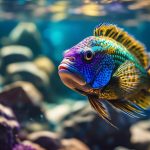The Black Phantom Tetra is a captivating freshwater fish species originating from the rivers of Paraguay and Brazil. It has gained popularity among aquarium enthusiasts due to its unique appearance and special care requirements. These peaceful schooling fish are an intriguing addition to any aquarium.
In this discussion, we will explore the fascinating world of the Black Phantom Tetra. We will cover various aspects, from its native habitat and availability to its tank requirements, feeding habits, breeding, and suitable tank mates.
Get ready to embark on a journey into the shimmering world of this captivating characin and discover the secrets of bringing it home.
Key Takeaways
- Black Phantom Tetras are native to the freshwater rivers of Paraguay and Brazil and are readily available in most aquariums.
- They have a peaceful temperament and are a schooling species that prefer to stick together.
- Black Phantom Tetras have specific care requirements, including a minimum tank size of 20 gallons, a temperature range of 72 to 82 degrees F, and pH levels between 6.0 to 7.5.
- When breeding Black Phantom Tetras, it is important to set up a separate breeding tank with specific conditions and provide live food for the spawning process.
Native Habitat and Availability
Black Phantom Tetras are native to the freshwater rivers of Paraguay and Brazil, and they are readily available in most aquariums. These shimmering Characin fish are a popular choice among aquarium enthusiasts due to their peaceful nature and striking appearance.
However, their natural habitat is also important to consider in the context of conservation efforts. Black Phantom Tetras are found in the Paraguay basin and the Madeira basin in South America, where they are plentiful in numbers. They inhabit backwaters, tributaries, lakes, and ponds, typically near patches of vegetation and tree roots.
In community aquariums, it is crucial to provide a suitable environment that mimics their natural habitat, including the presence of aquatic plants, hiding spots, and open swimming areas. By recreating their native surroundings, we can ensure the well-being and longevity of these beautiful fish while fostering an appreciation for their natural habitat.
Appearance and Temperament
The Black Phantom Tetra, a member of the Characidae family, displays distinct physical characteristics and exhibits a peaceful temperament within aquarium settings. These small fish have compressed bodies with a spindle-like shape, a forked caudal fin, and a well-defined anal fin. They also have a dark spot near the gills and show sexual dimorphism, with females being more colorful than males. Black Phantom Tetras are shoaling species that stick together, making them ideal for community tanks. They are generally peaceful and non-aggressive, although males may exhibit territorial aggression. Interestingly, when males engage in territorial disputes, they perform a parody of a fight rather than causing actual harm. After these disputes, they settle down and go back to their normal behavior. The Black Phantom Tetra is a fascinating fish to observe due to its beautiful appearance and peaceful temperament.
| Physical Characteristics | Temperament |
|---|---|
| – Compressed bodies with a spindle-like shape | – Shoaling species that stick together |
| – Forked caudal fin | – Peaceful and non-aggressive |
| – Well-defined anal fin | – Males can exhibit territorial aggression |
| – Dark spot near the gills | – Engage in a parody of a fight rather than causing actual harm |
| – Sexual dimorphism, with females being more colorful than males | – Settle down and go back to normal after territorial disputes |
Tank Requirements and Setup

To ensure the optimal conditions for Black Phantom Tetras, appropriate tank requirements and setup are crucial.
The tank size should be a minimum of 20 gallons, providing ample room for a group of these fish.
The water temperature should range between 72 to 82 degrees F, with a pH level maintained between 6.0 to 7.5. Water hardness levels should be around 10dGH for these characins.
It is important to provide hiding spots and open swimming areas in the tank, achieved through the use of appropriate aquarium decorations. Live plants should be added to create a natural environment, along with a mixture of sand and gravel substrate to mimic a riverbed.
Driftwood or rock decorations can also be included for a more natural look.
Regular water quality testing and proper filtration, as well as regular water changes, are essential for maintaining the ideal conditions for Black Phantom Tetras.
Feeding and Care
Feeding and care for Black Phantom Tetras involves providing a balanced diet and maintaining optimal tank conditions to ensure their health and well-being. Here are some important considerations:
- Feeding Habits:
- Black Phantom Tetras are omnivores and should be fed a varied diet.
- Offer them high-quality flakes as their staple food.
- Supplement their diet with live or frozen foods like brine shrimp or bloodworms.
- Feed them no more than twice a day to prevent overeating.
- Remove any leftover food from the tank to avoid water pollution.
Water Conditions:
- Black Phantom Tetras are sensitive to fluctuations in water conditions.
- Maintain a water temperature range of 72 to 82 degrees F.
- Keep the pH levels between 6.0 to 7.5.
- Aim for a water hardness range of 8 to 18dGH, with 10dGH being ideal.
- Ensure proper filtration and perform regular water changes to maintain water quality.
Breeding and Tank Mates

Black Phantom Tetras can be successfully bred in a separate breeding tank with the right conditions and careful observation of their spawning process. To breed Black Phantom Tetras, set up a breeding tank with a water heater and filter, maintaining a pH level of 5.5 and a water temperature of 77 degrees F. Provide aquatic plants and breeding grass in the tank to create a suitable environment.
Shift the male and female pairs to the breeding tank and feed them a live food diet while observing the spawning process.
When it comes to tank mates for Black Phantom Tetras, it is important to choose companions that are not aggressive. Tetras of similar size, such as other peaceful schooling species, make good tank mates. Gouramis, small Cichlids, and Rasboras are also suitable tank mates. However, it is advisable to avoid pairing them with slow-swimming species to prevent overeating.
Frequently Asked Questions
How Long Do Black Phantom Tetras Typically Live?
Black phantom tetras typically live for about 3 to 5 years. To keep them healthy, provide a spacious tank, maintain water temperature between 72 to 82 degrees F, and feed them a balanced diet of flakes and live/frozen foods.
Can Black Phantom Tetras Be Kept in a Community Tank With Other Fish?
Compatibility considerations for black phantom tetras in a community tank include choosing non-aggressive tank mates of similar size, such as gouramis, small cichlids, and rasboras. Avoid pairing them with slow-swimming species to prevent overeating.
Are Black Phantom Tetras Prone to Any Specific Diseases or Health Issues?
Black Phantom Tetras, like any fish, can be prone to specific diseases and health issues. Common diseases include ich, fin rot, and bacterial infections. Preventive measures such as proper tank maintenance and nutrition, along with prompt treatment, can help keep them healthy.
How Often Should the Tank Water Be Changed for Black Phantom Tetras?
Regular water changes are essential for maintaining the health of Black Phantom Tetras. It is recommended to change approximately 25% of the tank water every two weeks, which helps remove toxins, maintain water quality, and promote the overall well-being of the fish.
Do Black Phantom Tetras Require Any Specific Water Parameters for Breeding Success?
Breeding success for Black Phantom Tetras requires specific water parameters. Maintain a pH level of 5.5 and a water temperature of 77 degrees F in a separate breeding tank. Provide aquatic plants and breeding grass for optimal conditions.










